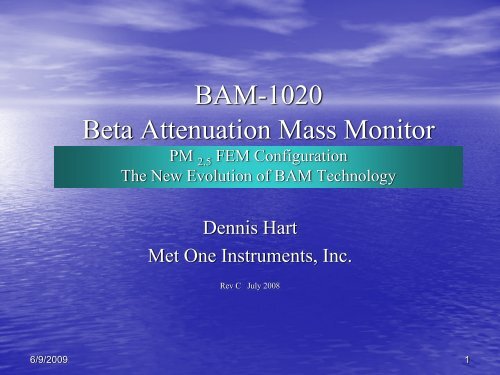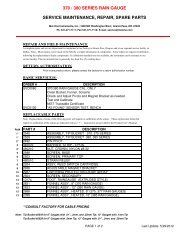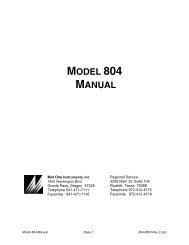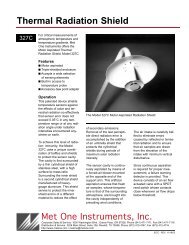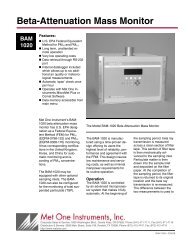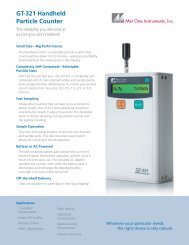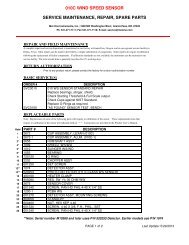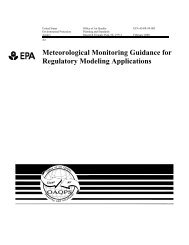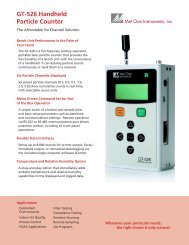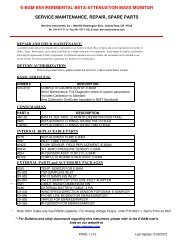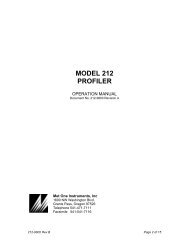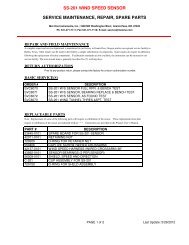PDF Download - Met One Instruments
PDF Download - Met One Instruments
PDF Download - Met One Instruments
- No tags were found...
You also want an ePaper? Increase the reach of your titles
YUMPU automatically turns print PDFs into web optimized ePapers that Google loves.
BAM-1020Beta Attenuation Mass MonitorPM 2.5 FEM ConfigurationThe New Evolution of BAM TechnologyDennis Hart<strong>Met</strong> <strong>One</strong> <strong>Instruments</strong>, Inc.Rev C July 20086/9/20091
Overview – The Big Picture• The success of any BAM-1020 monitoring programis directly proportional to how well the site operatorsand program administrators understand how and whythe unit works.• Basic knowledge of how and why (not just how) thevarious setups, checks, and calibrations are performedalways leads to better end results.• <strong>Met</strong> <strong>One</strong> is making a strong effort to provide thisinformation through improved documentation, fieldtraining, and expanded technical service.6/9/2009 2
Overview – Topics of Discussion• Brief History of the BAM-1020 PM2.5 Configuration• What is the FEM PM2.5 Configuration?• Basic Theory of Operation• Three Basic Systems: Flow, Measurement, and Data• Critical Checks and Maintenance• Measurement Challenges6/9/2009 3
Brief History of the PM2.5 FEM Configuration• 1930s - Beta attenuation measurement technology firstdeveloped for industrial processes and paper manufacturing.• 1970s - Beta attenuation technology adapted to measureairborne particulate levels.• 1990s – The <strong>Met</strong> <strong>One</strong> BAM-1020 was developed with reducedsize and advanced microprocessor control. EPA PM10 FEMapproval obtained in 1998.• 2002 – The <strong>Met</strong> <strong>One</strong> E-BAM was developed as a sister productfor rapid deployment and emergency response with variabledata intervals.• 2006 – The FEM PM2.5 BAM-1020 Configuration wasdeveloped and FEM testing began.• 2007 – PM2.5 FEM Candidate Configuration released for sale.• March, 2008 - EPA PM2.5 FEM designation obtained for theBAM-1020.6/9/2009 4
What is the PM2.5 FEM Configuration?• The classic BAM-1020 had appropriate accuracy andsensitivity for measuring PM10 levels, and was also often usedfor PM2.5 monitoring with the addition of a standard SCCcyclone or WINS impactor, even without equivalency.• Field results from these early PM2.5 systems showed that theBAM needed slight detection limit and Y-intercept (offset)improvements for accurate measurements below about 15micrograms. The slopes were typically quite adequate.• PM2.5 levels by nature are much more difficult to measure dueto low concentrations and greater volatile content. Smallmeasurement errors may cause large proportional errors.6/9/2009 5
What is the PM2.5 FEM configuration?• The transport assembly was redesigned for filter tapepositioning accuracy of about 1/1000 of an inch.• The beta source gap geometry was reduced 25%, resulting inhigher signal-to-noise levels and reduced air density effects.• The beta count time was increased from 4 to 8 minutes,improving the statistical noise stability by about 40%. Knownas the “2X” effect.• The firmware was extensively revised to provide flowstatistics, new settings, and improved field calibrations.• The field zero background test was implemented to fine-tunethe slope offset characteristics in the field.• The BX-596 Temp/Baro combination sensor was designed.6/9/2009 6
What is the PM2.5 FEM configuration?• The combined effect of these improvements resulted in thetypical detection limit (2σ) of the unit improving from about6ug to about 3ug for hourly measurements, and below 1ug for24 hour averages.• <strong>Met</strong> <strong>One</strong> began PM2.5 FEM testing immediately upon releaseof the final U.S. EPA specifications for candidate monitors.• The units had to meet stringent requirements for both FRMcorrelation and inter-unit comparison during both winter andsummer seasons at multiple sites around the country.6/9/2009 7
Factory Calibration Example6/9/2009 8
Data Example 1 – PM10 and PM2.5 Levels6/9/2009 9
Data Example 2 – PM10 and PM2.5 Levels6/9/2009 10
Data Example 3 – PM2.5 Slope / Offset6/9/2009 11
Data Example 4 – PM10 Slope / Offset6/9/2009 12
Typical older unimproved unit comparison toFRM for PM2.5, showing Y-intercept offset6/9/2009 13
What is the PM2.5 FEM configuration?• <strong>Met</strong> <strong>One</strong> filed the official FEM PM2.5 applicationwith the EPA in late summer 2007.• EPA review of the application took several months.• The BAM-1020 was the first instrument tosuccessfully complete PM2.5 FEM candidate testing,and is the first (and currently only) instrument toobtain EPA FEM status for PM2.5.• All BAM-1020 units built after March 2007 are FEMcompatible when equipped with the appropriatesettings and accessories.• The new BAM-1020 configuration maintains it’slongstanding FEM status for PM10 monitoring.6/9/2009 14
What is the PM2.5 FEM configuration?• The unit must use the EPA-mandated VSCC-A cyclone fromBGI Inc., and the standard EPA PM10 inlet.• The unit must be equipped with revision 3.2.4 or later firmware,and must be operated per the revision F or later manual.• The unit must use the BX-596 AT/BP sensor.• The unit must be operated with 8 minute counts and 42 minutesamples on standard glass fiber filter tape.• The unit must use the inlet Smart Heater, with an RH control setpointof 35%.• The unit must be set for Actual volumetric flow control.• The BKGD value must be audited in the field with the BX-302 zerofilter kit upon deployment.6/9/2009 15
What is the PM2.5 FEM configuration?• Many older units can be upgraded to the latest hardware andthe FEM PM2.5 version. The upgrade involves a completerebuild and calibration of the unit at the factory.• Units built before March, 2007 will need mechanical upgradesto the hardware before they can be configured for PM2.5. AllBAM-1020 units built after this have the latest hardware parts.• Most units built after 2003 (serial prefix C) are upgradeable.<strong>Met</strong> <strong>One</strong> does not recommend upgrades for older units.• Contact the Sales Dept for the current price of upgrades.• <strong>Met</strong> <strong>One</strong> now offers substantial discounts for trade-ins of oldunits. This also results in much faster turn around time than anupgrade of an old unit.6/9/2009 16
Theory of Operation• At the beginning of the hour, a smallCarbon 14 element emits a constantsource of beta rays through a clean spotof filter tape to determine a zero reading.• The unit advances this spot to the samplenozzle where air containing particulate issampled and deposited on the filter tape.• At the end of the hour, the dirty spot isplaced back at the source where is it remeasuredwith beta rays.• The difference between the twomeasurements is proportional to the massconcentration.6/9/2009 17
Mass Calculation−μxI = I0e1 ⎛ I ⎞x =− ln ⎜ ⎟μ ⎝ I0⎠AxC =V6/9/2009 18
Mass Calculation• DEFINITIONS:– I 0 – beta measurement across clean filter– I – beta ray measurement across dirty filter– μ – calibration coefficient– x – mass density on filter tape (mg/cm 2 )– A – dust spot deposition area on filter tape (cm 2 )– V – sampled volume (m 3 )– C – particulate matter concentration (mg/m 3 )6/9/2009 19
General Beta Gauge Advantages• Seasonal and geographical correction factors are notneeded.• It is not necessary to ever calibrate the betameasurement system in the field.• BAMs are calibrated to provide excellent agreementwith FRM gravimetric standards when properlymaintained and operated.• Beta technology is virtually unaffected by thechemical composition of the sampled particulate.6/9/2009 20
Beta Gauge Safety• The BAM-1020 contains a small amount of 14 C(Carbon 14), a naturally occurring radioactive isotopeof carbon, in the form of barium carbonate.• Activity level of the 60 µCi 14 C source is similar toseveral commercial smoke detectors, and is licensedwith the NRC under the same provisions.• Sources with activity under 100 µCi require nospecial government licensing to own.• <strong>Met</strong> <strong>One</strong> <strong>Instruments</strong> has an “Exempt DistributionLicense” from the US-NRC to distribute the betasources.6/9/2009 21
Beta Gauge Safety• Users are not required to take any specificprecautions when handling the BAM-1020 unit.• USA customers do not require any licenses to own a<strong>Met</strong> <strong>One</strong> beta gauge.• The end user will never need to remove, replace, orhandle the beta source.• The unit may be returned to the factory for disposal atthe end if its service life, although this is not required.6/9/2009 22
BAM-1020 Tape Transport6/9/2009 23
Simplicity – Flow System• The BAM-1020 airflowsystem consists of a fewsimple components:– Inlet/Nozzle– Filter Temp/RH/BP sensors– Debris filter– Honeywell mass flow sensor– Flow controller– Pump (external)6/9/2009 24
Simplicity – Measurement System• The BAM-1020 measurementsystem consists of a fewcomponents:– Carbon 14 Beta source– Filter tape control system– Photomultiplier detector– Preamp circuitry– Automatic hourly span check6/9/2009 25
Simplicity – Data System• The BAM-1020 data system consists of the CPU,data reports, user interface, error handling system,and telemetry.• All units are equipped with a six channel externaldata logger for external sensors.• The BAM-1020 may also function as a sensor in alarger data collection system using an externaldatalogger.6/9/2009 26
Critical Checks• Leak Check, Flow Check, Nozzle Cleaning!• The flow system should be calibrated or verified on aregular basis. Flow errors affect the concentration.• A leak check is performed with every flow check.Leaks cause measurement errors, and the unit cannotautomatically detect a leak.• The nozzle and support vane must be cleaned toprevent leaks and tape damage.• The nozzle and vane may need to be cleaned morefrequently in humid environments.6/9/2009 27
Critical Checks• The nozzle seal againstthe filter tape isimportant for properairflow regulation.• The nozzle and supportvane need to be cleanedat least as often as thefilter tape is changed.6/9/2009 28
BAM-1020 Span Check• The BAM-1020 makes an automatic span checkeach hour by measuring a Mylar calibration foilwith a constant and known mass density.• No calibration changes are made based on thespan check however.• If the span check falls outside of an acceptanceband, an error is generated.• The span check may be manually audited.6/9/2009 29
Measurement Challenges• Environmental conditions can play a role inthe accuracy of beta attenuation measurements.The main factors are:– Enclosure internal air temperature stability.– Relative humidity and sample moisture.– Electromagnetic and radio interference sources.6/9/2009 30
Measurement Challenges• Enclosure Temperature Stability:– The BAM-1020 should be in a stable temperatureenvironment, to the extent possible.– The exact temperature is not critical as long as it isfairly stable during the hour.– Changes in air density between the source anddetector may be measured as mass noise.6/9/2009 31
Measurement Challenges• Humidity:– The filter tape is semi-hydrophobic, but particulateon the tape is not.– Moisture accumulation on the sample spot may bemeasured as mass noise.– BAM-1020 uses smart heater technology to lowerthe RH of incoming air to about 35%.– Mild heat and hourly spot changes limit the effectson VOCs.– Humid conditions can increase nozzle fouling.6/9/2009 32
Electromagnetic Interference• Sources of high RF energy may cause noise in theBAM-1020 if in close proximity. Examples: Radiotowers or cell antennas in very close proximity.• Sources of high EMI fields may cause noise in thesystem. Examples: Large AC motors, Medical imagingequipment.• Static electricity (ESD) may cause measurement errors.• Lightning strike on the inlet will damage the unit.• Solutions: Proper site selection and grounding.6/9/2009 33
Conclusion• <strong>Met</strong> <strong>One</strong> <strong>Instruments</strong>, Inc. is constantly testing andexperimenting to improve the beta gauge productlines and documentation.• We welcome suggestions for future improvements.6/9/2009 34
Supplemental Materials• BAM-1020 Manual: Completely reorganized andrewritten for more value to the operator andadministrator. Available in electronic format forSOPs. Current Revision G.• BAM-1020 data sheet and specifications: Dependableand defensible.• www.metone.com BAM users area:Login: metone Password: oregon6/9/2009 35
Contacts• Sales:• Science:• Engineering:• Service:David Gobeli, Ph.D.Jo Ann PottbergPeter PomponiHerbert Schloesser, Ph.D.Dennis HartMike Putnam, Service Mgr.• Phone: (541) 471-71116/9/2009 36


